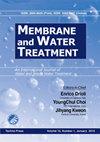用于定向溶剂萃取脱盐的非水溶剂中水和盐的脂肪:溶剂化学结构的影响
IF 1.1
4区 工程技术
Q4 ENGINEERING, CHEMICAL
引用次数: 14
摘要
众所周知,非水性溶剂(NASs)几乎不混溶,并且与极性化合物(如水)反应。然而,水可以与一些NAS相互作用,这可以作为从盐水中回收水的一种新方法。本研究探讨了当盐水与NAS混合时,水和盐在NAS中的去向。选择三种胺溶剂作为NAS。它们具有相同的分子式,但因其分子结构而不同,如下:1)在直碳链末端具有亲水基团(NH2)的NAS“A”,2)具有对称结构且在直碳链条中间具有亲水基团的NAS“B”,3)NAS“C”在直碳链末端具有亲水基团(NH2),但在结构中间具有疏水乙基分支。在分批实验中,将0.5M NaCl水与NAS混合,然后分别测量NAS中的水和盐含量。NAS‘B’和‘C’的吸水率分别为3.8%和10.7%。排盐率分别为98.9%和58.2%。NAS“A”表现出35.6%的较高吸水效率,尽管其排盐效率较差,为24.7%。分子动力学(MD)模拟显示了水和盐与每种NAS的不同相互作用。NAS“A”形成了晶格结构的团簇,亲水基团位于外侧,并在团簇口袋内捕获了大量的水分子和盐离子。NAS“B”形成了一个平面状的团簇,只有一些水分子,而没有盐离子迁移到NAS团簇。NAS“C”带有一个乙基分支,形成了一个类似于“B”的簇;然而,由于溶剂中的分支结构,团簇的边界表面看起来比“C”的边界表面更高。MD模拟通过证明不同NAS类型的水分子和盐之间的各种相互作用,有助于理解吸水和排盐的实验结果。本文章由计算机程序翻译,如有差异,请以英文原文为准。
Fates of water and salts in non-aqueous solvents for directional solvent extraction desalination: Effects of chemical structures of the solvents
Non-aqueous solvents (NASs) are generally known to be barely miscible, and reactive with polar compounds, such as water. However, water can interact with some NASs, which can be used as a new means for water recovery from saline water. This study explored the fate of water and salt in NAS, when saline water is mixed with NAS. Three amine solvents were selected as NAS. They had the same molecular formula, but were differentiated by their molecular structures, as follows: 1) NAS \'A\' having the hydrophilic group (NH2) at the end of the straight carbon chain, 2) NAS \'B\' with symmetrical structure and having the hydrophilic group (NH) at the middle of the straight carbon chain, 3) NAS \'C\' having the hydrophilic group (NH2) at the end of the straight carbon chain but possessing a hydrophobic ethyl branch in the middle of the structure. In batch experiments, 0.5 M NaCl water was blended with NASs, and then water and salt content in the NAS were individually measured. Water absorption efficiencies by NAS \'B\' and \'C\' were 3.8 and 10.7%, respectively. However, salt rejection efficiency was 98.9% and 58.2%, respectively. NAS \'A\' exhibited a higher water absorption efficiency of 35.6%, despite a worse salt rejection efficiency of 24.7%. Molecular dynamic (MD) simulation showed the different interactions of water and salts with each NAS. NAS \'A\' formed lattice structured clusters, with the hydrophilic group located outside, and captured a large numbers of water molecules, together with salt ions, inside the cluster pockets. NAS \'B\' formed a planar-shaped cluster, where only some water molecules, but no salt ions, migrated to the NAS cluster. NAS \'C\', with an ethyl group branch, formed a cluster shaped similarly to that of \'B\'; however, the boundary surface of the cluster looked higher than that of \'C\', due to the branch structure in solvent. The MD simulation was helpful for understanding the experimental results for water absorption and salt rejection, by demonstrating the various interactions between water molecules and the salts, with the different NAS types.
求助全文
通过发布文献求助,成功后即可免费获取论文全文。
去求助
来源期刊

Membrane Water Treatment
ENGINEERING, CHEMICAL-WATER RESOURCES
CiteScore
1.90
自引率
30.00%
发文量
0
审稿时长
>12 weeks
期刊介绍:
The Membrane and Water Treatment(MWT), An International Journal, aims at opening an access to the valuable source of technical information and providing an excellent publication channel for the global community of researchers in Membrane and Water Treatment related area. Specific emphasis of the journal may include but not limited to; the engineering and scientific aspects of understanding the basic mechanisms and applying membranes for water and waste water treatment, such as transport phenomena, surface characteristics, fouling, scaling, desalination, membrane bioreactors, water reuse, and system optimization.
 求助内容:
求助内容: 应助结果提醒方式:
应助结果提醒方式:


